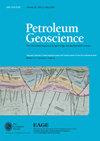Key controls on hydrocarbon retention and leakage from structural traps in the Hammerfest Basin, SW Barents Sea: implications for prospect analysis and risk assessment
IF 2.1
4区 地球科学
Q3 GEOSCIENCES, MULTIDISCIPLINARY
引用次数: 7
Abstract
Evidence of hydrocarbon leakage has been well documented across the SW Barents Sea and is commonly associated with exhumation in the Cenozoic. While fault leakage is thought to be the most likely cause, other mechanisms are possible and should be considered. Further study is required to understand what specific mechanism(s) facilitate such leakage, and why this occurs in some locations and not others. In a case study of the Snøhvit Field, we use seismic and well data to quantify fault- and top-seal strength based on mechanical and capillary threshold pressure properties of fault and cap rocks. Magnitude and timing of fault slip are measured to acknowledge the role that faults play in controlling fluid flow over time. Results based on theoretical and in situ hydrocarbon column heights strongly indicate that across-fault and top-seal breach by capillary threshold pressure, and top-seal breach by mechanical failure are highly unlikely to have caused hydrocarbon leakage. Instead, top-seal breach caused by tectonic reactivation of identified faults is likely to have facilitated hydrocarbon leakage from structural traps. The results of this case study acknowledge the different mechanisms by which hydrocarbons can leak from a structural trap. Employing both a holistic and quantitative approach to assessing different seal capacities reduces the likelihood that a particular cause of hydrocarbon leakage is overlooked. This is particularly relevant for the Snøhvit Field in its dual capacity as a producing gas field and as a carbon sequestration site since both systems rely on a thorough understanding of seal capacity and leakage potential.巴伦支海西南部Hammerfest盆地构造圈闭油气保留和泄漏的关键控制因素:前景分析和风险评估的意义
油气泄漏的证据在整个西南巴伦支海都有很好的记录,通常与新生代的挖掘有关。虽然故障泄漏被认为是最可能的原因,但其他机制也是可能的,应该加以考虑。需要进一步的研究来了解是什么具体机制导致了这种泄漏,以及为什么这种情况发生在某些位置而不是其他位置。在Snøhvit油田的案例研究中,我们根据断层和盖层的力学和毛管阈值压力特性,使用地震和井数据来量化断层和顶部密封强度。测量断层滑动的幅度和时间,以确认断层在控制流体随时间流动中所起的作用。基于理论和原位烃柱高度的结果强烈表明,毛细阈值压力对断层和顶封的破坏以及机械破坏对顶封的破坏不太可能导致油气泄漏。相反,由已识别断层的构造再激活引起的顶部密封破裂可能促进了构造圈闭的油气泄漏。本案例研究的结果承认了碳氢化合物从构造圈闭中泄漏的不同机制。采用整体和定量的方法来评估不同的密封能力,减少了忽视某一特定原因的可能性。对于Snøhvit气田来说,这一点尤为重要,因为这两个系统都依赖于对密封能力和泄漏潜力的全面了解。
本文章由计算机程序翻译,如有差异,请以英文原文为准。
求助全文
约1分钟内获得全文
求助全文
来源期刊

Petroleum Geoscience
地学-地球科学综合
CiteScore
4.80
自引率
11.80%
发文量
28
审稿时长
>12 weeks
期刊介绍:
Petroleum Geoscience is the international journal of geoenergy and applied earth science, and is co-owned by the Geological Society of London and the European Association of Geoscientists and Engineers (EAGE).
Petroleum Geoscience transcends disciplinary boundaries and publishes a balanced mix of articles covering exploration, exploitation, appraisal, development and enhancement of sub-surface hydrocarbon resources and carbon repositories. The integration of disciplines in an applied context, whether for fluid production, carbon storage or related geoenergy applications, is a particular strength of the journal. Articles on enhancing exploration efficiency, lowering technological and environmental risk, and improving hydrocarbon recovery communicate the latest developments in sub-surface geoscience to a wide readership.
Petroleum Geoscience provides a multidisciplinary forum for those engaged in the science and technology of the rock-related sub-surface disciplines. The journal reaches some 8000 individual subscribers, and a further 1100 institutional subscriptions provide global access to readers including geologists, geophysicists, petroleum and reservoir engineers, petrophysicists and geochemists in both academia and industry. The journal aims to share knowledge of reservoir geoscience and to reflect the international nature of its development.
 求助内容:
求助内容: 应助结果提醒方式:
应助结果提醒方式:


